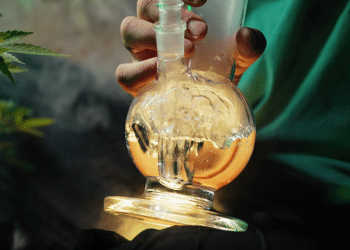Among the techniques to separate a solid-liquid mixture, gravity filtration is by far the most basic and it has been used since ancient times. Early in human history, people used to filtrate muddy water from rivers and lakes, letting it pass through sand or porous material in order to obtain clear water.
The same principle was widely applied in agriculture: the water from highlands was channeled to reach lowlands and during the path it was let passed through filters in order to retain rocks, branches or other impurities, obtaining clear water.
The gravity filtration principle is applied also in the carafes to purify water: depending on the kind of filter, the system is capable of holding back unwanted substances such as chlorine, microplastics, limestone, heavy metals among others.
Gravity filtration is commonly used also in chemistry laboratories and the method can be either applied to remove unwanted solid impurities from a solution or to isolate a solid material from a liquid mixture. If the process of filtration needs to be done faster another option is using vacuum filtration instead of gravity filtration. With the application of vacuum the liquid will be filtered out more efficiently from the solid material and the time of separation between the liquid and the solid will be shortened.
Gravity filtration ⎯ The method
To perform a standard gravity filtration it is necessary to have a filter paper and cut it of the right size that is a few millimeters below the rim of a stemmed funnel. The filter paper can be folded into a cone by first folding it in half, and then in half again. The semi-permeable paper is used to separate solid fine particles from a liquid or a gas and it will constitute the barrier of our separation.
Once the filter paper is placed in the stemmed funnel, the latter is placed into an Erlenmeyer flask, round bottom flask or other glassware depending on the needs. The filter paper can be wetted with a few milliliters of the solvent that will be used in the next step in order to hold in place the filter into the funnel. [1] [2]
The mixture to be filtered is poured into the funnel, into portions if necessary. The liquid will flow down thanks to gravity and the solid particles will accumulate in the filter paper.
Gravity filtration ⎯ limitations
If this method is used to evaluate the yield of a precipitation reaction, it should be noticed that gravity filtration can have some limitations.
The solid precipitate will adhere to the filter paper and if the operator is not accurate, it could be possible to have some discrepancies in the weight between the measured product yield and the final product yield.
Moreover with gravity filtration, the liquid needs more time to drip down in the bottom flask and the precipitate will stay wet of solvent for a longer time. If these things are not taken into account, it could be possible to have a wrong final weight thus the yield of our product.
Depending on the amount of precipitate in the filter and on the size of the particles, the solvent flow could stop due to filter clogging. The gravity filtration process could become particularly long and laborious.
It should be noticed that the filter could also brake and the solid particle could contaminate the underlying liquid. In this case the gravity filtration should be repeated but this could lead to additional time, solvent used, possible product loss etc.
It is always good practice to consider these downsides of gravity filtration before deciding which filtration method to employ. Depending on our needs, gravity filtration could lead to experimental errors and it could be less accurate than other methods such as vacuum filtration.
Gravity filtration ⎯ in the context of Cannabis
During cannabinoid content analyses of different cannabis chemovars, gravity filtration could be an option during the sample preparation for the laboratory analytical process.
We report here an example of the work-flow.
- The cannabis inflorescences can be grinded in order to enhance the surface subjected to the solvent and improve the cannabinoid extraction.
- After that a specific amount of ground cannabis is weighted and put into an Erlenmeyer flask.
- A certain amount of solvent such as ethanol or methanol can be added to the flask in order to extract all the cannabinoids from the plant material. The mixture can be put into an ultrasonic bath for a certain amount of time in order to speed up the extraction process.
- At this point we will pour the liquid into a paper filter placed in a funnel into a volumetric flask. The neck of volumetric flasks is elongated and narrow with a ring of graduation marking that should not be overcome in order to have the right dilution.
- The same plant material can be extracted for three consecutive times with fresh solvent and put into the ultrasonic bath in order to be sure to have extracted all the cannabinoids. Take care to not put too much solvent in order to have the right final dilution into the volumetric flask.
- As said the volumetric flask will help us to dilute our extraction liquid in order to not oversaturate the analytical equipment. To make an example if we put the concentrated solution of cannabis extract into the sampler of an high-performance liquid chromatography (HPLC), the high concentration of cannabinoids will result in a chromatogram out of scale, making useless the analysis and impossible the exact cannabinoid quantification.
- Once obtained the right dilution, the solution can be placed into a HPLC test tube and the analysis can be performed.
In this context the process of gravity filtration is used to avoid that the ground cannabis plant material enters into the extract. This could modify the final analysis and in some cases the solid particles could also clog the thin analysis needle of the HPLC machinery.
Vacuum Filtration
A way to overcome the downsides of gravity filtration is performing vacuum filtration. This method is particularly helpful when we need to perform the process in a short time and we need an accurate final result.
Vacuum filtration is mainly used to collect solid material coming from a precipitation reaction or from a recrystallization procedure.
This method can be performed using a Buchner funnel on a side-arm flask. The reduced pressure will force the flow of the liquid solution through a filter paper placed into the Buchner funnel. Keeping the reduced pressure for a while will help drying completely the solid accumulated in the funnel thus removing all the solvent excess.
If we are interested in collecting the liquid part instead of the solid, with vacuum filtration it is possible to maximize the yield because all the solvent will be forced out from the solid through reduced pressure. [1]
References:
[1] https://orgchemboulder.com/Technique/Procedures/Filtration/Filtration.shtml












